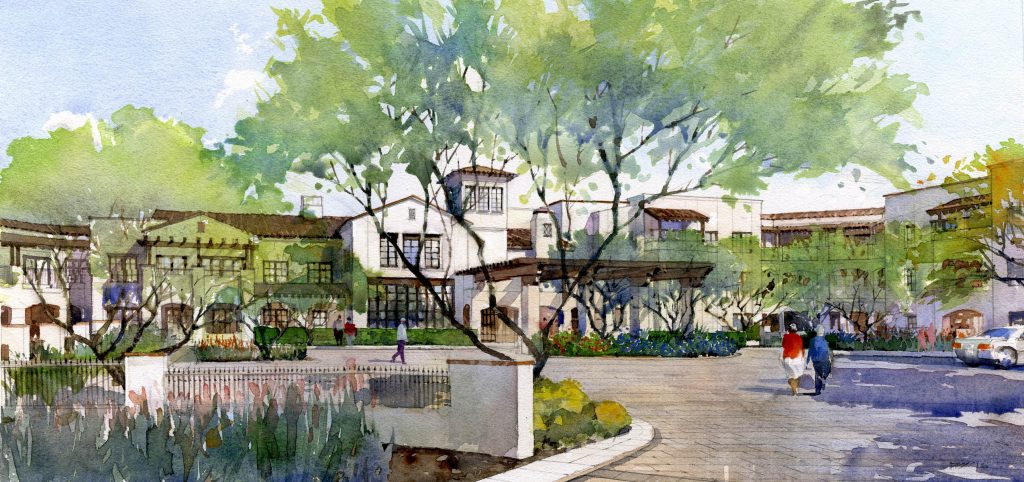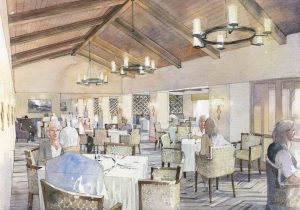In the foothills of Tucson, Arizona, a new type of senior housing offering is being developed by Watermark Retirement Communities.
The project, called The Hacienda at the Canyon, features an innovative pricing structure — including non-refundable membership fees of up to $60,000 — and an “integrative wellness” approach that blends high-end, resort-like amenities and on-site health care offerings.
With the community slated to open in spring 2019, more than 90% of its 163 independent living units were pre-leased as of last month. Perhaps even more notably, 50% of depositers were couples. This is more than double the average percentage in the rest of Watermark’s portfolio of about 40 properties.
These first residents are also younger, on average, than is usual. Much of the pre-leasing activity has been among those in their 70s, Watermark Chairman David Freshwater told Senior Housing News.
The Hacienda at the Canyon is in many ways an experiment for Watermark, but the Tucson-based company is encouraged by how the market has responded and plans to replicate this model at other locations going forward.
Bold choice, conservative underwriting
The Hacienda at the Canyon is being built on a 60-acre plot of land in the Santa Catalina Mountain foothills on the east side of Tucson. It is a picturesque setting, which will accommodate 4.5 miles of nature trails and offers easy access to the Loop, a 132-mile paved trail system that circles the city.
“Here we are on what we thought was the best and only remaining piece of land in the foothills on which a senior living community of this size could be built,” Freshwater said.
Watermark first made a deal to purchase the real estate about a decade ago. This initial project stalled, however, when the financial crisis hit.
Once the economy was back on a stable footing, the development was revived. This time, Watermark negotiated a four-phase purchase with the Sisters of the Immaculate Heart of Mary, who owned the real estate and still own about 100 acres of adjacent land, where they reside.
The project’s first phase involves the construction of the independent living units as well as 68 assisted living residences and 40 memory care residences. The next phases will involve the construction of casitas — small standalone homes — and bungalows. Watermark eventually will have the option to purchase more land, at the Sisters’ discretion.
Before the economy tanked in 2008, Watermark had planned to construct a traditional continuing care retirement community (CCRC). When the project got a second life, those plans changed.
“We hired ProMatura and did very extensive research, including focus groups and questionnaires to people in the market,” Freshwater said. “We tested, on a whim, this idea of not an entry fee or rental [model], but the idea of an upfront fee that is non-refundable. It tested very positively.”
This research convinced Watermark that a membership fee model would work, because it would support a high-end CCRC-quality product that consumers wanted, but would not demand that they tie up large sums of money via a six-figure entrance fee.
The company underwrote the project based on membership fees of $1,500. This was a very conservative number, Freshwater acknowledges, and the actual fee levels are more than 20 times that amount.

“We knew, based on the market research, that there was a good chance that this membership fee concept was going to sell, but there’s a big difference between getting in front of 40 people in a focus group and getting people to put a deposit down,” Freshwater said. “We came out of the gate charging $40,000 to $60,000, and we’ve never turned back. No one’s blinked an eye.”
The $60,000 level is for the community’s 40 or so “club units,” which feature Pro Line appliances, tile accents, backsplashes, glass-fronted cabinetry and other premium touches. These units have sold out.
Having planned to collect $600,000 from fees through the project’s hold period, Watermark has secured more than $6 million. As a result, it revised its plans to the tune of about $3 million, upgrading common areas, artwork, and making other improvements to make sure that the community will meet residents’ expectations, Freshwater said.
Watermark is also unbundling its pricing structure as much as it can, particularly in independent living. Each resident will have a point-of-service (POS) card loaded with $500 each month, drawn from the monthly rate that each person is charged. They will be free to use that $500 any way they choose, whether it’s on food in the multiple dining venues, bottles of wine, personal training, spa services or even “500 apples,” Freshwater joked.
Assisted living residents will be on a dining plan due to regulations, but there will not be a dedicated AL dining room. Instead, these residents will be free to choose among the community’s many dining options. Seeing where these residents opt to eat and adjusting to those patterns will be something that Watermark is looking to learn. But the company is committed to the concept of choice, which Freshwater believes is key to attracting a younger demographic.
“My mom, even when she was 85, said, ‘I like to cook and I don’t want to be told I have to eat 30 meals in the dining room,’” Freshwater said.
Watermark’s definition of wellness
“Wellness” has become a buzzword in recent years, in senior living and other industries. The word is used in so many different ways, it’s hard to know what it signifies.
“You can go to the wellness spa in the strip mall, and they’re doing Botox or massage, or there are wellness centers that are health clinics,” Freshwater said. “A lot of retirement communities had a wellness clinic, and it was by and large a health clinic for having your blood pressure checked, et cetera.”
For The Hacienda at the Canyon, “wellness” begins with a high-end resort-like experience, he emphasized. The plans include spa treatment rooms, a 45-foot outdoor lap pool, a fully equipped fitness center, a movement studio, and daily offerings such as yoga and tai chi. In memory care, horses will be brought on site for equine therapy, which Watermark has already introduced at a nearby property.
There will also be a health component, including an onsite medical clinic leased to a physician group providing concierge-style services. All members of the community will have access to both a geriatrician and a nurse practitioner and can take part in programming — say, a session on healthy diets — and will have a personalized wellness plan. Technology will be layered in to electronically track participation and help residents achieve their unique goals.
It’s this multi-layered approach that Watermark refers to as “integrative wellness.” The concept is so central to the vision for these new type of developments, the company is calling them “integrative wellness centers.”
Two other developments — one in the Los Angeles area and the other in Napa — will also operate on this model. An earlier-stage development in Marco Island, near Houson, is also being underwritten on this model, and Watermark now has the confidence to plan for higher membership fees.
A high-profile project in Brooklyn will bring in some of these elements, although licensing issues in New York City present some constraints. Still, Freshwater believes this is the way of the future.
“As we go forward and develop, particularly for the independent living population, this will probably be what all of our projects are,” he said.
The model does demand high barrier to entry markets, with a population affluent enough to pay membership fees. And these developments aren’t cheap; phase one of The Hacienda at the Canyon ran to the $80 million to $85 million range. But Watermark’s new equity partner, Keppel Corp., is a believer in this model.
Though enthusiastic about the pre-leasing success at The Hacienda at the Canyon, Freshwater anticipates that there will be a learning curve, with surprises and challenges ahead.
“I’m knocking on wood,” he said. “So far, it’s been good news.”
Written by Tim Mullaney



